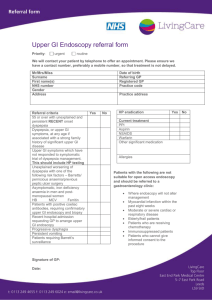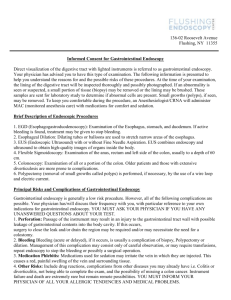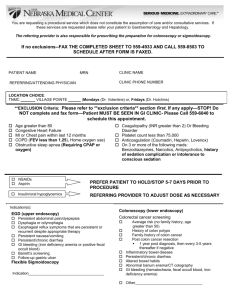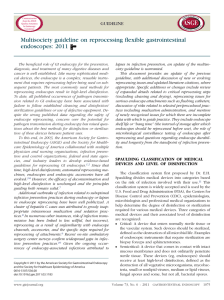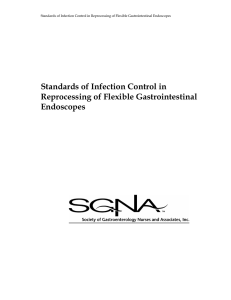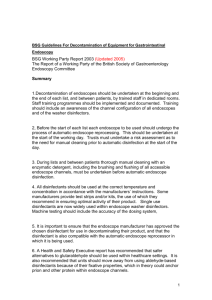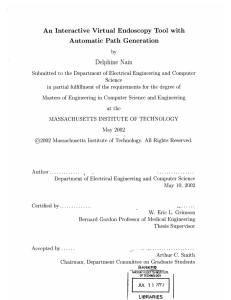Ettinger: Textbook of Veterinary Internal Medicine, 7th Edition
advertisement
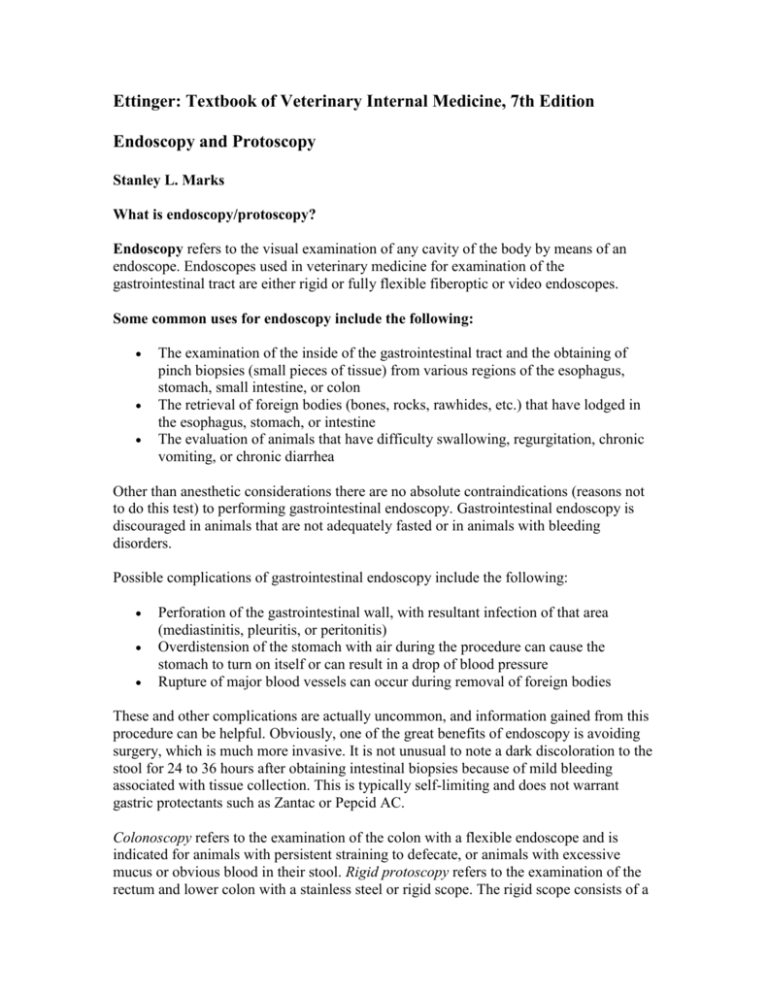
Ettinger: Textbook of Veterinary Internal Medicine, 7th Edition Endoscopy and Protoscopy Stanley L. Marks What is endoscopy/protoscopy? Endoscopy refers to the visual examination of any cavity of the body by means of an endoscope. Endoscopes used in veterinary medicine for examination of the gastrointestinal tract are either rigid or fully flexible fiberoptic or video endoscopes. Some common uses for endoscopy include the following: The examination of the inside of the gastrointestinal tract and the obtaining of pinch biopsies (small pieces of tissue) from various regions of the esophagus, stomach, small intestine, or colon The retrieval of foreign bodies (bones, rocks, rawhides, etc.) that have lodged in the esophagus, stomach, or intestine The evaluation of animals that have difficulty swallowing, regurgitation, chronic vomiting, or chronic diarrhea Other than anesthetic considerations there are no absolute contraindications (reasons not to do this test) to performing gastrointestinal endoscopy. Gastrointestinal endoscopy is discouraged in animals that are not adequately fasted or in animals with bleeding disorders. Possible complications of gastrointestinal endoscopy include the following: Perforation of the gastrointestinal wall, with resultant infection of that area (mediastinitis, pleuritis, or peritonitis) Overdistension of the stomach with air during the procedure can cause the stomach to turn on itself or can result in a drop of blood pressure Rupture of major blood vessels can occur during removal of foreign bodies These and other complications are actually uncommon, and information gained from this procedure can be helpful. Obviously, one of the great benefits of endoscopy is avoiding surgery, which is much more invasive. It is not unusual to note a dark discoloration to the stool for 24 to 36 hours after obtaining intestinal biopsies because of mild bleeding associated with tissue collection. This is typically self-limiting and does not warrant gastric protectants such as Zantac or Pepcid AC. Colonoscopy refers to the examination of the colon with a flexible endoscope and is indicated for animals with persistent straining to defecate, or animals with excessive mucus or obvious blood in their stool. Rigid protoscopy refers to the examination of the rectum and lower colon with a stainless steel or rigid scope. The rigid scope consists of a hollow tube with an eyepiece on one end and a light source with a fiber bundle for the transmission of light to the inside end of the tube that allows one to see. Rigid protoscopy is indicated for the initial evaluation of dogs and cats with signs of large bowel disease. This recommendation is made because rigid protoscopy entails less risks, time, and cost than colonoscopy, yet is able to diagnose the majority of large bowel diseases, because such diseases are commonly diffuse (i.e., colitis). Furthermore, the large majority of large bowel cancers are located close to the anus. If a diagnosis is not apparent using rigid protoscopy, if your veterinarian perceives and increased likelihood of upper colonic disease, if he or she wishes to effectively evaluate disease extent, or attain a photographic record, colonoscopy should be performed. What preparations are needed? Adequate preparation of the animal is essential for successful visualization and effective biopsy of the mucosa, and for preservation of equipment. A period of starvation is essential. Three days of starvation is ideal (where possible, begun at home), 2 days will often suffice, and 1 day is rarely adequate. The most effective cleansing of the entire colon is attained by the use of solutions such as COLYTE or GoLYTELEY. These solutions contain an osmotic agent and replacement electrolytes. They are administered to your pet by stomach 3 to 4 tubes over a period of 12 to 24 hours prior to the procedure. Enemas are less desirable for the preparation of the colon prior to colonoscopy. They are less effective at cleansing (especially the upper portion of the colon) and they can produce artificial abnormalities. In most animals, however, they are easier and less timeconsuming to administer. They are also less expensive. It is important to run the enema into the animal by gravity only and to avoid additives in the enemas. Soap, especially if in high concentrations, can induce colitis in susceptible humans. Fleet enemas and rectal administration of bisacodyl laxatives both alter protoscopic and histologic appearance of the mucosa. Furthermore, Fleet enemas have been associated with fatal hyperphosphatemia and hypernatremia in cats. Scopettes are large "Q tips" that can be used to swab out residual fecal material from the rectum. What are some other uses of endoscopy? Endoscopy can also be used to facilitate dilation of esophageal strictures. These strictures may occur from gastroesophageal reflux (often during anesthesia), esophageal foreign bodies, neoplasia, and the ingestion of caustic substances. The endoscope allows visual assessment and biopsy of strictures if necessary before dilation. This helps differentiate post-inflammatory strictures, extraesophageal compressions, and strictures resulting from neoplasia, thus facilitating the selection of an appropriate therapy. Furthermore, endoscopy simplifies the placement of the effect of the procedure on the mucosal tissue, and luminal diameter. Dilation of strictures can be performed by balloon catheter or rigid dilators. Rigid bougies are less desirable than balloon dilators because they produce less radial force and more shearing forces; however, they are still effective in many situations. Complications of bougienage and balloon catheter dilation are not uncommon, particularly in inexperienced hands. Complications include perforation of friable esophageal tissues, and the rupture of major periesophageal vessels entrapped by the inflammatory or neoplastic disease process that formed the stricture. Endoscopes are invaluable for facilitating the placement of a stomach feeding tube (percutaneous endoscopic gastrostomy tube) that is indicated for long-term (weeks to months) nutritional support of anorectic animals, animals with megaesophagus, or animals with difficulty swallowing.

